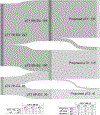Depth of invasion versus tumour thickness in early oral tongue squamous cell carcinoma: which measurement is the most practical and predictive of outcome?
- PMID: 33112422
- PMCID: PMC8079561
- DOI: 10.1111/his.14291
Depth of invasion versus tumour thickness in early oral tongue squamous cell carcinoma: which measurement is the most practical and predictive of outcome?
Abstract
Aims: The 8th edition of the American Joint Committee on Cancer (AJCC) Staging introduced depth of invasion (DOI) into the pT category of oral cavity squamous cell carcinoma. However, we noted multiple practical obstacles in accurately measuring DOI histologically in our daily practice.
Methods and results: To compare the prognostic effects of DOI and tumour thickness (TT), a meticulous pathology review was conducted in a retrospective cohort of 293 patients with AJCC 7th edition pT1/T2 oral tongue squamous cell carcinoma. Overall survival (OS) and nodal metastasis rate at initial resection were the primary and secondary outcomes, respectively. We found that TT and DOI were highly correlated with a correlation coefficient of 0.984. The upstage rate was only 6% (18 of 293 patients) when using TT in the pT stage compared with using DOI. More importantly, DOI and TT, as well as pT stage using DOI and pT stage using TT, performed identically in predicting risk of nodal metastasis and OS.
Conclusions: We therefore propose to replace DOI, a complicated measurement with many challenges, with TT in the pT staging system.
Keywords: AJCC staging; depth of invasion; oral tongue squamous cell carcinoma; prognosis; tumour thickness.
© 2020 John Wiley & Sons Ltd.
Conflict of interest statement
Figures





Similar articles
-
Practical Challenges in Measurement of Depth of Invasion in Oral Squamous Cell Carcinoma: Pictographical Documentation to Improve Consistency of Reporting per the AJCC 8th Edition Recommendations.Head Neck Pathol. 2020 Jun;14(2):419-427. doi: 10.1007/s12105-019-01047-9. Epub 2019 Jun 22. Head Neck Pathol. 2020. PMID: 31230230 Free PMC article.
-
Small oral tongue cancers (≤ 4 cm in diameter) with clinically negative neck: from the 7th to the 8th edition of the American Joint Committee on Cancer.Virchows Arch. 2018 Oct;473(4):481-487. doi: 10.1007/s00428-018-2417-y. Epub 2018 Jul 23. Virchows Arch. 2018. PMID: 30039390
-
Early squamous cell carcinoma of the oral tongue with histologically benign lymph nodes: A model predicting local control and vetting of the eighth edition of the American Joint Committee on Cancer pathologic T stage.Cancer. 2019 Sep 15;125(18):3198-3207. doi: 10.1002/cncr.32199. Epub 2019 Jun 7. Cancer. 2019. PMID: 31174238 Free PMC article.
-
Radiological approach for the newly incorporated T staging factor, depth of invasion (DOI), of the oral tongue cancer in the 8th edition of American Joint Committee on Cancer (AJCC) staging manual: assessment of the necessity for elective neck dissection.Jpn J Radiol. 2020 Sep;38(9):821-832. doi: 10.1007/s11604-020-00982-w. Epub 2020 Apr 30. Jpn J Radiol. 2020. PMID: 32356237 Review.
-
The prognostic role of the pre-treatment neutrophil to lymphocyte ratio (NLR) and tumor depth of invasion (DOI) in early-stage squamous cell carcinomas of the oral tongue.Oral Maxillofac Surg. 2022 Mar;26(1):21-32. doi: 10.1007/s10006-021-00969-5. Epub 2021 Jun 9. Oral Maxillofac Surg. 2022. PMID: 34106358 Review.
Cited by
-
Variability in Depth of Invasion Measurements in Carcinomas of the Oral Cavity and the Effect on Pathologic Tumor Staging.Head Neck Pathol. 2022 Dec;16(4):963-968. doi: 10.1007/s12105-022-01439-4. Epub 2022 Apr 30. Head Neck Pathol. 2022. PMID: 35499641 Free PMC article.
-
Tumor thickness and depth of invasion in squamous cell carcinoma of tongue as indicators of the loco-regional spread of the disease: A preliminary study.J Oral Biol Craniofac Res. 2024 Jul-Aug;14(4):423-429. doi: 10.1016/j.jobcr.2024.05.006. Epub 2024 May 24. J Oral Biol Craniofac Res. 2024. PMID: 38832293 Free PMC article.
-
Efficacy of Computed Tomography and Magnetic Resonance Imaging in the Assessment of Depth of Invasion in Oral Squamous Cell Carcinoma: Analysis of 125 Clinical Cases.Diagnostics (Basel). 2023 Dec 1;13(23):3578. doi: 10.3390/diagnostics13233578. Diagnostics (Basel). 2023. PMID: 38066819 Free PMC article.
-
Value of radiological depth of invasion in non-pT4 Oral tongue squamous cell carcinoma: implication for preoperative MR T-staging.Eur Radiol. 2024 Sep;34(9):6047-6059. doi: 10.1007/s00330-024-10598-7. Epub 2024 Feb 3. Eur Radiol. 2024. PMID: 38308013 Free PMC article.
-
Prognostic value of radiological T category using conventional MRI in patients with oral tongue cancer: comparison with pathological T category.Neuroradiology. 2024 Jun;66(6):907-917. doi: 10.1007/s00234-024-03345-8. Epub 2024 Apr 12. Neuroradiology. 2024. PMID: 38607437 Free PMC article.
References
-
- Bray F, Colombet M, Mery L et al.Cancer incidence in five continents, vol. Xi, iarc cancerbase no. 14: International Agency for Research on Cancer (IARC), 2019.
-
- Amin MB, Edge SB, GF L et al.Ajcc cancer staging manual. Eighth edition. New York: Springer Nature, 2017.
-
- Edge SB, Byrd DR, Compton CC, Fritz AG, Greene FL, Torotti A. Ajcc cancer staging manual. Seventh edition. New York: Springer-Verlag, 2010.
-
- Spiro RH, Huvos AG, Wong GY, Spiro JD, Gnecco CA, Strong EW. Predictive value of tumor thickness in squamous carcinoma confined to the tongue and floor of the mouth. Am J Surg 1986;152;345–350. - PubMed
-
- Huang SH, Hwang D, Lockwood G, Goldstein DP, O’Sullivan B. Predictive value of tumor thickness for cervical lymph-node involvement in squamous cell carcinoma of the oral cavity: A meta-analysis of reported studies. Cancer 2009;115;1489–1497. - PubMed
MeSH terms
Grants and funding
LinkOut - more resources
Full Text Sources

